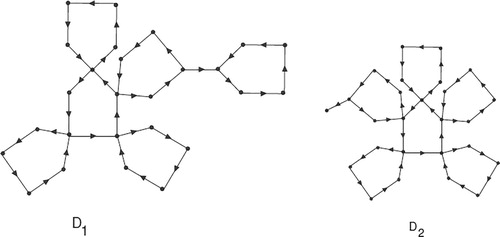 ?Mathematical formulae have been encoded as MathML and are displayed in this HTML version using MathJax in order to improve their display. Uncheck the box to turn MathJax off. This feature requires Javascript. Click on a formula to zoom.
?Mathematical formulae have been encoded as MathML and are displayed in this HTML version using MathJax in order to improve their display. Uncheck the box to turn MathJax off. This feature requires Javascript. Click on a formula to zoom.ABSTRACT
In Section 4 of the original paper ‘Complex adjacency matrix and energy of digraphs’, we incorrectly asserted that the iota energy of digraphs increases with respect to the quasi-order relation defined over if
. In this corrigendum, we point out errors and correct them where possible.
1. Increasing property of iota energy
In Section 4 of the original paper [Citation1], we incorrectly calculated the formulas (4.14) and (4.15) of energy and iota energy, respectively, for the polynomial of the form . The correct formulas for energy and iota energy of the polynomial
are given below:
and
where θ is the principal argument of
and
.
The statement of Theorem 4.2 [Citation1] is flawed as it was proved using the formulas (4.14) and (4.15). In the next theorem, we give correct statement of Theorem 4.2 [Citation1]. The proof is similar.
Theorem 1.1
Let be a digraph. Then there are functions
and
such that
The following expression is proved correctly in Theorem 4.5 [Citation1]:
Based on the above expression, we erroneously stated that the iota energy increases with respect to the quasi-order relation ≼ defined over
if
. The digraphs shown in Figure disprove Theorem 4.5 [Citation1]. That is, the iota energy in general does not possess the increasing property over the set
when
.
Theorem 4.6 [Citation1] was proved using Theorem 4.2 [Citation1] and thus the assertion of Theorem 4.6 [Citation1] is not correct. The digraphs shown in Figure disprove Theorem 4.6 [Citation1]. That is, the iota energy in general may not possess the increasing property over the set when
.
Finally, Theorem 4.7 [Citation1] was a consequence of Theorems 4.2 and 4.5 [Citation1] and thus may not be correct. However, we failed to find a counter example to disprove the Theorem 4.7 [Citation1].


